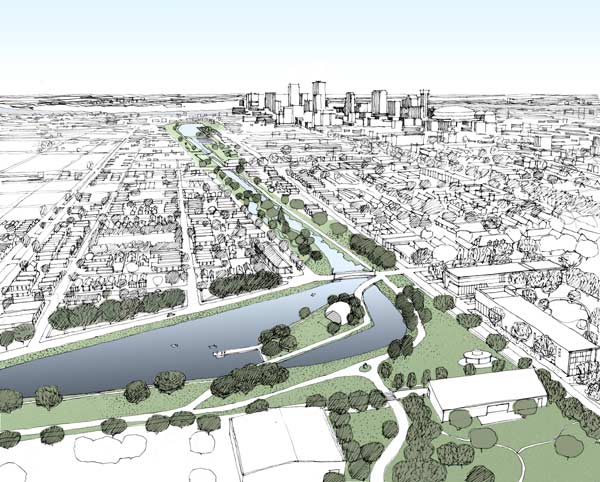 |
| Image courtesy Waggonner & Ball |
| An international team led by Waggonner & Ball is designing a water-management plan for New Orleans. |
Since Hurricane Katrina devastated New Orleans in 2005, local architect David Waggonner has been working to improve the way his city deals with water. In 2008, he initiated the Dutch Dialogues, a series of workshops that aimed to facilitate conversations about water issues between New Orleans and the Netherlands. His firm Waggonner & Ball also has projects that draw from the Dutch concept of “living with water,” such as Lafitte Greenway, an urban park with widened “bayous” that absorb rainwater during extreme storms.
Overall, Waggonner’s goal is to encourage his city to follow the lead of the Dutch, who use water-control strategies that emulate natural systems rather than relying solely on dikes and barriers. “We in New Orleans have the opportunity to become a more resilient ecological city,” Waggonner says.
Now, his firm has been tapped for a project that could have major impact. In March, Greater New Orleans (GNO), an economic development agency comprising a variety of stakeholders, announced that a proposal by an international team led by Waggonner & Ball had won the design competition for a water-management strategy for the Crescent City. Entrants were charged with rethinking the city’s entire water-management system, especially in regards to land subsidence, rising sea levels, and an overburdened stormwater system. Over the next 15 months, the team will refine its proposal and, in the end, present an implementation plan.
The Waggonner & Ball team consists of architecture, landscape architecture, and engineering firms from the United States and the Netherlands. The Dutch cities of Rotterdam and Amsterdam also collaborated with the group. Their winning proposal has three core stages: water system design; water-based urban planning at the district scale; and conceptual design of several pilot projects at various scales.
The firm’s proposal suggests a balance between hydraulic systems, such as pumps, and natural systems that can absorb excess stormwater and take pressure off a city’s mechanical infrastructure. Proposed strategies range from street-side rain gardens lined with hydrophilic plants to large urban waterways, where stormwater is kept on the surface rather than piped underground. “The focus is on using the earth and natural systems to inform urban design,” says Waggonner. “This requires a paradigm shift from the pipe-and-pump model.”
Funding for the project comes from a $2 million award from the Louisiana Office of Community Development-Disaster Recovery Unit and the U.S. Department of Housing and Urban Development.


Post a comment to this article
Report Abusive Comment